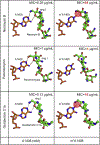Aminoglycoside Resistance: Updates with a Focus on Acquired 16S Ribosomal RNA Methyltransferases
- PMID: 33011054
- PMCID: PMC10927307
- DOI: 10.1016/j.idc.2020.06.002
Aminoglycoside Resistance: Updates with a Focus on Acquired 16S Ribosomal RNA Methyltransferases
Abstract
The clinical usefulness of aminoglycosides has been revisited as an effective choice against β-lactam-resistant and fluoroquinolone-resistant gram-negative bacterial infections. Plazomicin, a next-generation aminoglycoside, was introduced for the treatment of complicated urinary tract infections and acute pyelonephritis. In contrast, bacteria have resisted aminoglycosides, including plazomicin, by producing 16S ribosomal RNA (rRNA) methyltransferases (MTases) that confer high-level and broad-range aminoglycoside resistance. Aminoglycoside-resistant 16S rRNA MTase-producing gram-negative pathogens are widespread in various settings and are becoming a grave concern. This article provides up-to-date information with a focus on aminoglycoside-resistant 16S rRNA MTases.
Keywords: 16S rRNA methyltransferases; Aminoglycosides; Gram-negative bacteria; Plazomicin.
Copyright © 2020 Elsevier Inc. All rights reserved.
Conflict of interest statement
Conflict of interest The authors declare no conflicts of interest associated with this article.
Figures






References
-
- Blair JM, Webber MA, Baylay AJ, et al. Molecular mechanisms of antibiotic resistance. Nat Rev Microbiol 2015;13(1):42–51. - PubMed
-
- Jones D, Metzger HJ, Schatz A, et al. Control of gram-negative bacteria in experimental animals by streptomycin. Science 1944;100(2588):103–5. - PubMed
-
- Waksman SA, Lechevalier HA. Neomycin, a new antibiotic active against streptomycin-resistant bacteria, including tuberculosis organisms. Science 1949;109(2830):305–7. - PubMed

